We’ve all seen skateboarders launch into the air, nailing amazing skate tricks. How do they do these skateboard air stunts? Whether you’re a novice skateboarder or a seasoned skater, we’ve got you covered. In this skateboard trick guide, we’ll explore the basics of skateboarding and gradually ascend into the realm of trick skating.

We understand these stunts might seem daunting at first glance; they involve defying gravity on a wooden board with wheels! But don’t worry – our tips and techniques are designed to build your confidence and skills step by step. By serving as your trustworthy guide in this exciting journey upward, we hope to ignite your passion for soaring high on your skateboard. Let’s get started!
We’ll discover how to perform skateboarding trick moves, the techniques needed to nail them, and how to land them safely. We’ll also learn what type of skateboard is best for air stunts and the necessary protective gear for a safe and successful flight. Soar high with us and get ready to experience the thrill of skateboard air stunts! Don’t forget to share your progress and feedback with us along the way.
Key Takeaways
Skateboarding is a captivating and skill-based activity encompassing various elements, including ramps, skateboards, and various stunts. Mastering this thrilling sport requires dedication, practice, and a willingness to learn and improve continuously. It offers individuals a platform for self-expression and creativity, allowing them to showcase their unique style and personality on the skateboard. However, safety is paramount in skateboard riding, and wearing protective gear is essential to prevent injuries while exploring new tricks and challenges.
With its freedom and excitement, skateboard riding appeals to people of all ages and skill levels, providing recreational enjoyment and opportunities for competitive endeavors. Learning and mastering tricks is a gradual process, and it is crucial to start with the basics before venturing into more advanced maneuvers.
As skaters draw inspiration from legendary skateboarders and their signature trick moves, they are empowered to push the boundaries of what’s possible on a skateboard. Beyond being a physical activity, skateboard riding fosters confidence, perseverance, and a sense of community among enthusiasts, creating a vibrant and dynamic culture that resonates with skateboarders worldwide.
Skateboard Basics
Skateboard riding is a popular recreational activity and sport involving riding a four-wheeled board called a skateboard. It requires finding your stance (regular or goofy), pushing to gain momentum, balancing and turning, and stopping using various techniques. Beginners can learn basic tricks like ollies and kick turns. Safety gear and respect for others in public spaces are essential. With practice and patience, you can enjoy the fun and self-expression that skateboard riding offers.
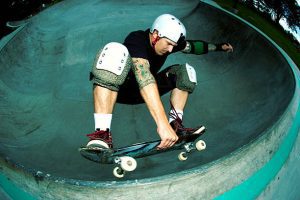
Remember, skateboard riding is about having fun and expressing yourself. Don’t be discouraged by falls or challenges. With dedication and perseverance, you’ll improve your skills and enjoy the thrilling world of skateboard riding.
Aerial Skate Tricks
Let’s take a thrilling ride into the realm of skateboard air stunts. We’ll delve into these high-flying maneuvers’ fascinating history and evolution, tracing their roots and spotlighting some game-changing skateboarders who’ve left their mark with signature stunts. Buckle up because we’re about to embark on an adrenaline-pumping exploration that will deepen our appreciation for this bold art form.
Evolution & History Of Skateboarding Tricks
Skateboard air stunts have come a long way since their inception and have become a defining aspect of modern skateboarding culture. These high-flying maneuvers involve lifting the skateboard off the ground and executing trick moves while airborne, showcasing the skater’s creativity, style, and technical skills.
The history of air stunts can be traced back to the 1970s when the vertical skateboard riding scene began flourishing. Skaters like Tony Alva, Jay Adams, and Stacy Peralta pushed what was possible on a skateboard, experimenting with airs and spins in empty swimming pools and skate parks. These early pioneers laid the foundation for air skateboarding and inspired a new generation of skateboarders to take to the skies.
In the 1980s, the introduction of the halfpipe ramp further fueled the development of air stunts. Skateboarders like Tony Hawk, Christian Hosoi, and Steve Caballero became known for their groundbreaking trick moves, such as the McTwist and Christ Air. These stunts combined kickflips, spins, and grabs, elevating skateboard riding to new heights and captivating audiences worldwide.

As skateboard riding progressed into the 1990s and 2000s, vert skateboard riding saw a surge in popularity with events like the X Games and the inclusion of skateboard riding in the Olympics. Skaters like Bob Burnquist, Bucky Lasek, and Shaun White continued to innovate and push the boundaries of what was possible in air skateboard riding.
In recent years, air tricks have evolved even further with the rise of “big air” skateboard riding, where skaters perform jaw-dropping tricks over massive gaps and ramps. Athletes like Pedro Barros, Mitchie Brusco, and Nyjah Huston have taken air skateboard riding to new heights, performing complex combinations of flips, spins, and grabs that were once considered unimaginable.
Overall, the history and evolution of air stunts in skateboard riding showcase the sport’s constant progression and the creative spirit of its athletes. From the early days of pool skating to the modern era of big air competitions, air stunts continue to captivate audiences and push the boundaries of what’s possible on a skateboard. So, let’s gear up and get ready to witness some mind-blowing air performances that leave us in awe of these fearless skateboarders.
Famous Skateboarders And Their Signature Stunts
Throughout skateboard riding’s history, numerous legendary skateboarders have significantly impacted the sport with their signature stunts. These skaters pushed the boundaries of what was possible on a skateboard and inspired generations of riders to pursue their own innovative styles.
Famous longboarders showcase signature stunts like early grabs, and seatbelt grabs, and perform air tricks, often influenced by experiences at places like the Swedish skate camp and inspiration from Tony Hawk’s Pro Skater, with a focus on proper form, such as keeping knees pointed.
- Tony Hawk is known for his groundbreaking 900 Spin.
- Rodney Mullen revolutionized street riding with the kickflip.
- Christian Hosoi popularized the stylish Christ Air.
- Bob Burnquist’s signature trick was the Fakie 900.
- Nyjah Huston mastered the Kickflip Backside Tailslide.
- Bucky Lasek’s signature trick is the Stalefish 540.
- Lizzie Armanto’s signature is the One-Footed Backside Air.
These skateboarders have influenced the sport’s evolution, inspiring skaters worldwide to push their limits and embrace creativity on a skateboard. Tony Hawk also invented the judo air or turning backside, it allows skaters, like the real trick inventor, to confidently perform other tricks while maintaining a skater crouch and protect their front leg during turning maneuvers.
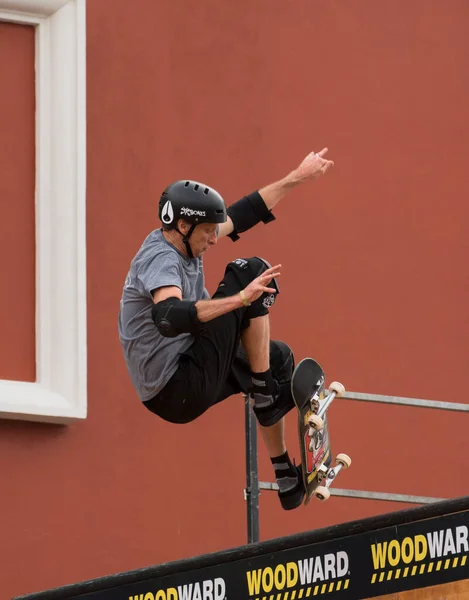
Importance Of Safety Gear
Safety gear is essential for skateboarders to protect themselves from potential injuries and accidents. It includes helmets, knee pads, elbow pads, and wrist guards, which provide cushioning and support during falls or collisions. Safety gear in skateboarding is important because in addition to preventing injuries during trick skating.
Safety gear instills confidence, supports learning, and sets a positive example for others. It is especially crucial for young skaters and helps comply with regulations in certain areas. Safety gear ensures skateboarders can enjoy the sport responsibly, irrespective of the skating environment. Prioritizing safety by wearing appropriate gear minimizes the risks and promotes a safer and more enjoyable skateboard riding experience.
Physical Conditioning And Training
Physical conditioning and training are vital for skateboarders to enhance performance, prevent injuries, and improve overall well-being. It involves cardiovascular fitness, strength training, flexibility, balance, and coordination exercises.
Core strength and plyometrics also contribute to better skateboard riding skills. Rest, recovery, and injury prevention are essential aspects—cross-training and gradual progression aid in achieving consistent improvement. A well-rounded training program helps skateboarders optimize their abilities and enjoy a safer and more fulfilling skateboard riding experience.
Basic Aerial Tricks
Ready to take your skateboard riding skills to the next level? Here are some basic air tricks in skateboard riding that you can start practicing:
- Ollie: The Ollie is the foundation for many air stunts. It involves popping the tail of the board down while sliding your front foot forward to level the board in the air.
- Grab Trick: Try incorporating grabs once you’re comfortable with the Ollie. Grab the board while in the air, such as the Indy grab (the front hand grabs the board between the feet) or the Melon grab (the back hand grabs the board between the feet).
- Boneless: The Boneless is a classic stunt where you use your front foot to step off the board, grab the board in the air, and land back on the board.
- No-Comply: The No-Comply involves lifting your front foot off the board, tapping the tail with your back foot, and then jumping back on while the board is in the air.
- Fastplant: With the Fastplant, you use one hand to push off the coping or the lip of a ramp while grabbing the board with your other hand.
- Axle Stall: In this stunt, you ride up the ramp, turn 90 degrees, and place both trucks on the coping. Balance there briefly before dropping back in.
- Rock to Fakie: Ride up the ramp, pivot 180 degrees on the front wheels, and ride backward.
- Kickturns: A basic maneuver where you turn the board on the back or front wheels while riding on a ramp.
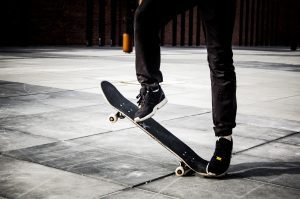
Remember to start with small ramps and practice these tricks in a controlled environment with proper safety gear. As you gain confidence and control, you can progress to more challenging air tricks and expand your skateboard riding repertoire. Happy skating!
Advanced Aerial Tricks
Advanced air tricks take skateboard riding to a new level, combining technical skill, style, and fearless execution. These tricks are typically performed on larger ramps or gaps and require more experience and confidence. Here are some advanced air tricks in skateboard riding:
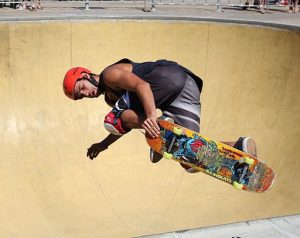
- 540 Spin: A 540 spin involves spinning the board 540 degrees (1 and a half spins) while grabbing the board.
- McTwist: The McTwist is a 540-degree backside spin combined with a frontside flip, resulting in a unique twisting motion.
- Backflip Variations: Some riders have attempted backflip variations over large gaps or ramps, adding a new dimension to the stunt.
- Frontside or Backside Rodeo Flips: These stunts involve combining a flip with a 180 or 360-degree spin, creating a stylish and technical air maneuver.
- Big Airs: Riders attempt massive airs, launching high above ramps and gaps, and executing various spins, flips, and grabs.
- One-Footed Variations: Riders perform advanced stunts with one foot off the board, like one-footed 540s or one-footed backside flips.
- Varial Flips and Heelflips: Adding a 180-degree body varial while performing a flip trick results in an impressive and complex combination.
- No-Hand Variations: Some riders attempt stunts without using their hands to grab the board, adding an extra element of difficulty and style.
- Inverts: In an invert, the rider grabs the board with one hand while performing a backside or frontside rotation.
- Double Flips: Riders attempt other flip stuntslike double kickflips or heelflips, performing two rotations of the board while airborne.
It’s essential to approach advanced air tricks with caution and proper preparation. These tricks often come with higher risks of injury, so wearing the right safety gear and ensuring you have the necessary skill level and experience is crucial. Skaters usually spend years perfecting their craft before attempting these high-level maneuvers.
Progression, dedication, and a focus on safety are key to mastering advanced air tricks and pushing the boundaries of skateboarding. Always remember to skate within your abilities and seek guidance from experienced skaters or coaches to develop the skills required for advanced air maneuvers.
Aerial
As we dive into the world of air skateboarding tricks, let’s not forget that they’re no walk in the park. The key lies in practice and persistence – it’s about dusting ourselves off from our mistakes, learning from them, and using those lessons to fine-tune our technique.
Mastering aerial stunts involves focusing on essential tips such as tucking the knee (tuck knee), incorporating a back leg, executing tricks like kickflip indy, and adjusting body positioning for maneuvers like stinkbug air and les twist on a half-pipe or front rail. We’ll stumble and falter, but with grit and determination, we’ll conquer these feats and redefine our limits.
Importance Of Practice And Persistence
To master aerial skateboarding tricks, practice, and persistence are essential. Start with basic tricks, progress gradually, and focus on proper technique. Practice and persistence are crucial in skateboarding, as they enable skateboarders to master tricks like the pop shove it (pop shuvit), the tail of the board, and skateboard ollies, fostering improvement and camaraderie with other skateboarders.
Visualize success, analyze mistakes, and seek feedback from experienced skaters. Consistent practice, a positive mindset, and safety prioritization are crucial. Stay fit and flexible, learn from others, and be patient with your progress. Celebrate small achievements and keep pushing your boundaries to achieve remarkable feats in aerial skateboarding.
Learning From Mistakes And Improving Techniques
To master aerial skateboarding tricks, learning from mistakes and improving technique are crucial. Embrace mistakes as learning opportunities and analyze errors to understand areas for improvement. Seek feedback from experienced skaters, record and review your attempts, and break down complex tricks into smaller components. Use visualization to enhance muscle memory and stay patient, persistent, and positive throughout the learning process.
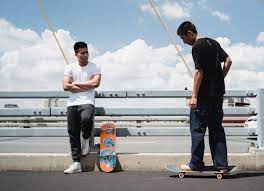
Prioritize safety, practice regularly, and celebrate even small progress. Learn from others, reflect on your growth, and enjoy the rewarding journey of becoming a skilled aerial skateboarder.
Conclusion
Skateboarding aerial stunts may seem daunting initially, but with the proper guidance and practice, anyone can learn to soar high on their skateboard.
Starting with the basics of skateboarding, we gradually ascend into aerial stunts. Whether you’re a novice or a seasoned pro, our tips and techniques are designed to build your confidence and skills step by step. Safety is paramount, so we emphasize the importance of wearing protective gear and learning to fall correctly.
Skateboarding aerial stunts have a rich history, evolving from the early pioneers like Tony Alva and Stacy Peralta to the modern-day legends like Nyjah Huston and Pedro Barros. As we explore the world of aerial tricks, we pay homage to these game-changers who have inspired skaters worldwide.
From mastering the Ollie and grab tricks to advancing to more complex maneuvers like 540 spins and McTwists, we provide a comprehensive guide for skateboarders to progress and challenge themselves safely. With consistent practice and a positive mindset, skateboarders can learn from mistakes, improve techniques, and achieve remarkable feats in aerial skateboarding.
The journey to mastering aerial tricks is filled with ups and downs, but dedication and perseverance lead to thrilling moments of success. So gear up, strap on your safety gear, and get ready to experience the exhilarating rush of skateboarding aerial stunts.
Remember to stay patient, learn from others, and enjoy the rewarding journey of becoming a skilled aerial skateboarder. Let’s soar high together and push the boundaries of what’s possible on a skateboard!
Frequently Asked Questions
How do you do an aerial on a longboard?
Performing an aerial on a skateboard involves launching yourself into the air while the skateboard stays beneath your feet. To execute an aerial, approach a ramp or a jump with enough speed and crouch down as you reach the lip.
As you go up the ramp, extend your body and lift both feet off the skateboard, performing various grab tricks such as indy air, frontside air, or heelflip slob air by grabbing the skateboard with one or both hands. Hold the grab while in the air, adding your own style and creativity to the maneuver. Then, bring your feet back onto the skateboard to land smoothly.
Aerials require a combination of skill, confidence, and precise timing to execute correctly, making them an exciting and challenging aspect of skateboarding that showcases the skateboarder’s ability to defy gravity and perform tricks mid-air. As with any skateboarding trick, practicing aerials in a safe and controlled environment with proper safety gear is essential to mastering this impressive feat.
What is a Benihana trick?
A Benihana is a skateboarding trick where the skater grabs the front of the skateboard with one hand while the other hand extends outwards in a similar fashion to a grab in snowboarding. The skateboard is typically tucked between the legs during the grab, and the skater releases the grab before landing back on the skateboard on flat ground. This grab trick adds a stylish and unique flair to the skater’s aerial maneuver.
The Benihana can be performed on various terrains, including ramps and flat ground, showcasing the rider’s creativity and skill in executing a visually captivating trick. It’s important to note that the Benihana is not commonly seen in competitive skateboarding, but it remains a favorite among skaters who seek to showcase their individuality and inventiveness.
What is the trick where the skateboard is flipped upside down?
The trick where the skateboard is flipped upside down is commonly known as an inward heelflip. It involves flicking the heel of your back foot diagonally down and towards the nose of the skateboard, causing it to rotate in an inward direction while flipping upside down.
What is a Japan Air?
A Japan Air is an aerial skateboard trick where the rider grabs the heel edge of the skateboard with one hand while extending the opposite leg straight out behind them, creating a stylish and eye-catching maneuver. The Japan Air is commonly performed on vert ramps or in transition skateboarding, allowing the skater to showcase their control and flair in the air.
This trick is named after Mike McGill, who was inspired by a snowboarding move called the Method Air, and he adapted it to skateboarding, coining it the McTwist or 540 McTwist. The McTwist is considered one of the most iconic and challenging tricks in skateboarding, requiring skill, confidence, and a willingness to push the boundaries of what’s possible on a skateboard.
The McTwist is commonly performed on large halfpipe ramps, where the rider launches into the air, performs a 540-degree spin while grabbing the skateboard, and then lands back on the ramp. This trick is a testament to the innovation and progression in skateboarding, and it continues to inspire and captivate skaters and audiences worldwide.
What is a Rocket Air?
A Rocket Air is a stylish and challenging skateboard trick where the rider grabs the nose of the skateboard with one hand while extending the opposite leg straight out in front of them. This maneuver adds a dynamic and visually appealing element to the skater’s aerial performance. The Rocket Air is often performed on vert ramps or in transition skateboarding, allowing the rider to demonstrate their control and creativity in the air.
This trick requires balance, coordination, and confidence, making it a favorite among skilled skateboarders seeking to elevate their aerial repertoire. The Rocket Air is a testament to the ever-evolving nature of skateboarding, where skaters continuously push the boundaries and find new ways to express themselves through innovative and daring tricks.
What is a gay twist?
The gay twist is a skateboard trick involving the skateboarder grabbing the skateboard’s tail with one hand and twisting their body in the opposite direction, hence the name. The gay twist is typically performed on a ramp or halfpipe, where the rider gains speed and approaches the ramp’s wall.
As they go up the ramp, they crouch down, grab the skateboard’s tail with their trailing hand, and initiate the twist by rotating their upper body in the opposite direction of the grab. The skateboard follows their body’s motion, creating the twist in mid-air. To complete the trick, the rider releases the grab and lands smoothly back on the ramp. The Gay Twist requires precise timing, control, and body coordination, making it an impressive and challenging aerial trick.
How many spins is a 900?
A 900 skateboard trick involves performing two and a half spins (900 degrees) in the air. Tony Hawk first successfully executed this challenging and iconic trick during the 1999 X Games on a vert ramp. The trick requires the skateboarder to launch off the ramp, perform two and a half full rotations while keeping their eyes on the coping, and then land back on the skateboard.
It is an incredibly difficult and rare maneuver, as the skateboarder needs to generate significant height and rotational speed to complete the spins successfully. Tony Hawk’s historic achievement of the 900 at 31 showcased his unparalleled skills and innovation in skateboard riding, forever cementing his legacy in the sport. The 900 remains one of the most awe-inspiring skateboard trick moves, and it continues to inspire and challenge skateboarders to push the boundaries of what’s possible on a skateboard. Tony Hawk is a legend in the skateboard world.
What is a crail grab?
The crail grab is a skateboard trick where the rider grabs the toe side of the skateboard with their trailing hand while in mid-air. To execute the Crail Grab, the skateboarder typically starts in a crouched starting position and approaches a ramp or halfpipe. As they go up the ramp, they extend their body and reach down to grab the toe side of the skateboard.
The skateboard follows their motion, creating a stylish and unique grab in mid-air. The rider then releases the grab and lands back on the ramp smoothly. Another variation of this grab is the Lien Air, where the skateboarder grabs the heel side of the skateboard with their trailing hand similarly.
Additionally, the Body Jar is another aerial trick where the rider grabs the heel side of the skateboard with their leading hand and rotates their body, facing the skateboard during the grab and then releasing the grab before landing back on the ramp. These grabs add flair and individuality to skateboard tricks, showcasing the rider’s creativity and style in the air.
What is a half-cab stunt?
To perform a half-cab trick, the skater crouches down and approaches the obstacle or ramp switch, which means riding with their non-dominant foot at the back and dominant foot at the front. As they go up the ramp, they execute a 180-degree turn in mid-air, landing with their dominant foot at the back and riding away in the regular stance.
This trick is a variation of the Caballerial, named after skateboarder Steve Caballero, and is a fundamental trick for skaters looking to add variety to their aerial repertoire. Once a skater has mastered the Half Cab, they can incorporate it with other skateboard tricks and combine different grabs or rotations to showcase their creativity and individual style.
Is a kickflip harder than an ollie?
Yes, a kickflip is generally considered harder than an ollie. While both require practice and skill, the kickflip involves simultaneously popping the tail and flicking the skateboard with your front foot to make it flip. The coordination and timing required for a kickflip make it more challenging than the basic ollie, a fundamental trick in skateboard riding involving a simple jump with the skateboard staying on the ground.
Last Updated on June 9, 2024 by Jeanne Meets
DISCLAIMER (IMPORTANT): This information (including all text, images, audio, or other formats on FamilyHype.com) is not intended to be a substitute for informed professional advice, diagnosis, endorsement or treatment. You should not take any action or avoid taking action without consulting a qualified professional. Always seek the advice of your physician or other qualified health provider with any questions about medical conditions. Do not disregard professional medical advice or delay seeking advice or treatment because of something you have read here a FamilyHype.com.